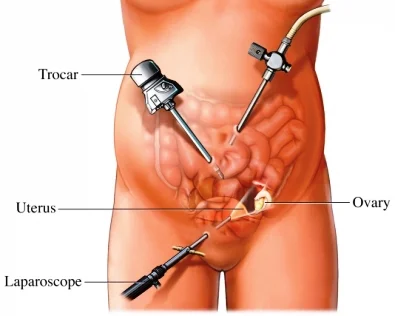- Home
- Departments
- Lap Assisted Vaginal Hysterectomy
Lap Assisted Vaginal Hysterectomy

Laparoscopic assisted vaginal hysterectomy is a procedure to remove the uterus and ovaries through the vagina. It is a procedure which converts an abdominal hysterectomy to vaginal hysterectomy.
Book an Appointment
Overview
Obstetrics and Gynecology Women’s health is a very critical component of any hospital’s offering. Right from puberty to pregnancy, child birth to menopause, women go through a host of health issues which need to be addressed from time to time.
An abdominal hysterectomy entails an abdominal incision 8-10 cms in length, and splitting the abdominal muscles. LAVH is done laparoscopically through the abdomen under general anaesthesia.
LAVH has advantages over abdominal hysterectomy:
- less morbidity/pain postoperative
- earlier recovery
- better cosmesis
Complications:
- Injury to bowel
- injury to ureters/ urinary bladder
- bleeding
How the procedure typically works
- Preparation: Before the surgery, the patient is usually given general anesthesia to ensure they are unconscious and pain-free during the procedure. The patient’s abdomen and genital area are cleaned and sterilized to reduce the risk of infection.
- Creation of Pneumoperitoneum: The surgeon makes small incisions in the abdomen, usually around the belly button, to insert a laparoscope—a thin, lighted tube with a camera on the end. Carbon dioxide gas is then pumped into the abdomen to create space for the surgeon to work and to improve visualization.
- Visualization of Pelvic Organs: With the laparoscope inserted, the surgeon can view the pelvic organs, including the uterus, ovaries, and surrounding structures, on a monitor. This allows for a clear view of the surgical site and helps guide the procedure.
- Dissection and Removal of Uterus: Using specialized instruments inserted through additional small incisions in the abdomen, the surgeon carefully detaches the uterus from surrounding tissues and blood vessels. Once detached, the uterus is removed through the vagina.
- Closure and Recovery: After the uterus is removed, any incisions are closed with sutures or surgical staples. The patient is then monitored in a recovery area until they wake up from anesthesia and their vital signs are stable. Most patients can go home the same day or after a short hospital stay, depending on individual circumstances.
Obstetrics and gynecology (OB/GYN) offer a comprehensive range of services and treatments to address various aspects of women’s reproductive health. Here are some of the key services and treatments provided:
Obstetric Services:
- Prenatal Care: Regular check-ups and monitoring during pregnancy to ensure the health of both the mother and the developing baby.
- Ultrasound Imaging: Used to visualize the fetus and monitor its growth and development.
- Labor and Delivery Care: Management and support during childbirth, including pain management options and assistance with labor.
- High-Risk Pregnancy Management: Care for women with conditions such as gestational diabetes, hypertension, or multiple pregnancies that may increase the risk during pregnancy.
- Cesarean Section (C-Section): Surgical delivery method when vaginal delivery is not feasible or safe.
- Postpartum Care: Follow-up care for mothers after childbirth to monitor recovery and address any complications.
Gynecological Services:
- Routine Exams: Annual gynecological exams, including pelvic exams and Pap smears to screen for cervical cancer and other abnormalities.
- Contraceptive Counseling and Management: Guidance on birth control options and management of contraceptive methods such as oral contraceptives, intrauterine devices (IUDs), and implants.
- Management of Menstrual Disorders: Diagnosis and treatment of conditions like irregular periods, heavy bleeding (menorrhagia), and painful periods (dysmenorrhea).
- Treatment of Gynecological Infections: Diagnosis and management of sexually transmitted infections (STIs) and other gynecological infections.
- Infertility Evaluation and Treatment: Assessment of factors contributing to infertility and treatment options such as fertility medications, intrauterine insemination (IUI), and in vitro fertilization (IVF).
- Menopause Management: Support and treatment for symptoms associated with menopause, including hormone replacement therapy (HRT) and lifestyle modifications.
Surgical Procedures:
- Hysterectomy: Surgical removal of the uterus, either partially or completely.
- Oophorectomy: Removal of one or both ovaries.
- Myomectomy: Surgical removal of uterine fibroids.
- Tubal Ligation: Permanent sterilization procedure for women who do not wish to have more children.
- Endometrial Ablation: Procedure to remove or destroy the uterine lining to treat heavy menstrual bleeding.
These are just some of the many services and treatments offered by obstetricians and gynecologists to address the diverse needs of women’s reproductive health throughout their lives.
Investigations Price List
Treatments Price List
Frequently Asked Questions
Health Care Plans
Our doctors include highly qualified male and female practitioners who come from a range of backgrounds and bring with a diversity of skills and special interests. Our administration and support staff all have exceptional people skills and trained to assist you with all medical enquiries.
- Review your medical records.
- Check and test blood pressure.
- Run tests such as blood tests.
- Check and test lung function.
- Narrowing of the arteries.
- Other specialized tests.
24 hrs Emergency Facility
If you need an emergency appointment call on the following numbers for emergency service.

